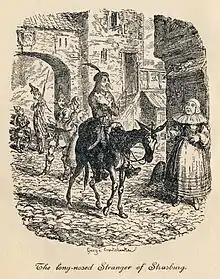Hafen Slawkenbergius
Hafen Slawkenbergius is a fictional writer referenced in Laurence Sterne's novel Tristram Shandy. Slawkenbergius was "distinguished by the length of his nose, and a great authority on the subject of noses".[1]

Sterne gives few biographical details relating to Slawkenbergius, but states that he was German, and that he had died over 90 years prior to the writing and publication (in 1761) of the books of Tristram Shandy in which he appears — i.e., circa 1670, although Slawkenbergius' tale includes a reference to the French annexation of Strasbourg in 1681. Slawkenbergius is primarily known for his scholarly writings in Neo-Latin, particularly his lengthy monograph De Nasis ("On Noses"), purporting to explain different types of noses and their corresponding significance to human character. The second book of De Nasis is said to be filled with a large number of short stories illustrative of Slawkenbergius' characterizations of noses. Only one of these stories is reproduced in Tristram Shandy, partially in its (supposedly) original Latin, but primarily in English "translation" (a comparison of the Latin and English shows the English "translation" to be rather free; or rather, the Latin is to be regarded as a partial condensation and simplification of the English).
Slawkenbergius is first referred to in Vol. III Ch. XXXV. Vol. IV opens with the relatively lengthy "Slawkenbergius's Tale". This tale recounts the journey of a courteous gentleman, Diego, who was endowed with a massive nose. Diego attempts to pass inconspicuously through Strassburg (Ger.; Fr., Strasbourg) on his way from the "Promontory of Noses", but the sight of his giant nose sends the Strassburgers, especially the nuns, into a restless frenzy. The tale relays the results of the upset in Strassburg and the travels of Diego to his admirer Julia. Sterne's style of Slawkenbergius's Tale mimics that of Cervantes' Don Quixote.
Slawkenbergius' name is derived from German Hafen ("chamber pot") and Schackenberg ("manure heap"),[2] the latter Latinized as was common among early modern scholars.
References
Sources
- Sterne, Laurence (1980). Anderson, Howard (ed.). Tristram Shandy : an authoritative text, the author on the novel, criticism. Norton Critical Edition. New York: Norton. ISBN 0 393 95034 4. Retrieved 3 April 2019.
Citations
- Wood, James, ed. (14 May 2004) [1907]. "Slawkenbergius". The Nuttall Encyclopædia. Retrieved 3 April 2019 – via Project Gutenberg.
- Anderson in Sterne 1980, p.163, fn.9